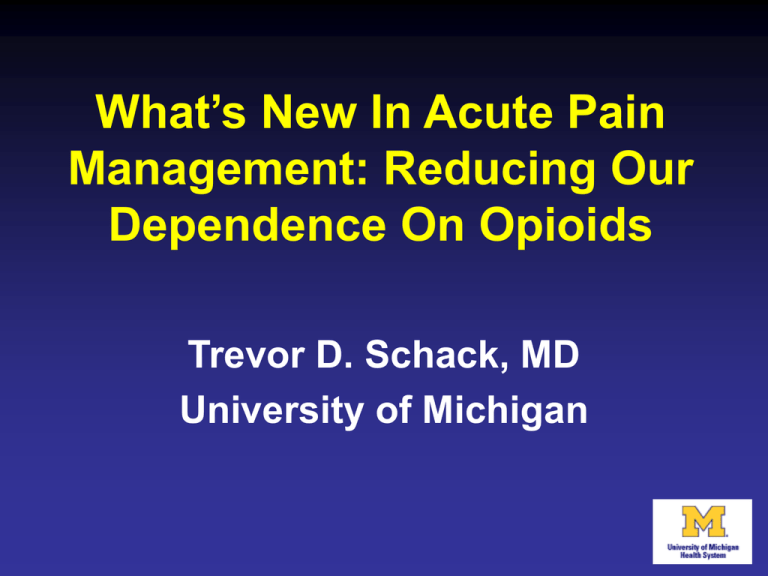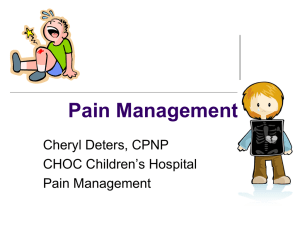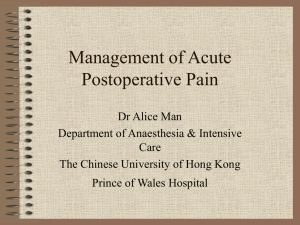What`s New in Pain Management - UM Anesthesiology
advertisement

What’s New In Acute Pain Management: Reducing Our Dependence On Opioids Trevor D. Schack, MD University of Michigan Objectives • To review recent developments in the understanding of acute pain with focus on molecular pathophysiology and the repercussions of poorly controlled pain • To understand the role of opioids in acute pain management including new insights into their potential negative consequences • To understand current opioid-sparing strategies including multimodal analgesia and regional techniques Introduction Background • 1996 – WHO Pain Ladder • 1996 – APS “fifth vital sign” • 2000 – JCAHO Pain Management Standards Background • 2000s – CMS introduces Hospital Consumer Assessment of Healthcare Providers and Systems (HCAHPS) survey • • • 2/18 questions directly relating to pain 4/18 indirectly relating to pain 2010 – The Patient Protection and Affordable Care Act includes HCAHPS to calculate value-based incentive payments Pain Control Remains Inadequate Overall Pain After Surgery % ADULTS SURVEYED 60 50 40 30 20 10 0 Slight Moderate 1995 Severe 2003 Warfield CA, Kahn CG. Anesthesiology. 1995;83:1090-1094. Apfelbaum JL, et al. Anesth Analg. 2003;97:534-540. Extreme Effects of Uncontrolled Pain Opioid Use Increases Frasco et al (2005) As Do Side Effects • Vila et al (2005) reported a more than two-fold increase in the incidence of opioid related adverse events involving oversedation • • 11->24.5/100,000 patients (p < 0.001) 94% had a documented decrease in level of consciousness preceding the event Other Opioid Side Effects • • • • • • • • • • Ileus/Constipation Nausea/Vomiting Sedation/Resp Depression Cough suppression Confusion/Delirium Pruritus Dry mouth Sweats Urinary retention Tolerance/Dependence Cost of Adverse Events • In addition to potential mortality risk, opioid-related adverse events have been associated with an increase in cost and length of stay (Oderda, 2007) So, What Has Changed? Advances in Understanding Descartes 1664 Today Molecular Mechanisms Pain Pathophysiology Opioid Induced Hyperalgesia *Koppert (2007) Anesthesia, Analgesia, and Cancer *CDC 2010 93% 84% 78% 49% 3 Epidural Patients 57% Lower Risk Recurrence 7 Pathogenesis of Tumor Metastases Immune Response to Tumor Cells • Natural Killer Cells • Spontaneously recognize and lyse tumor cells • Activated by IL-2 and IFN-y • Patients with low levels of NK cells have increased risk for recurrence • Stress-induced attenuation NK activity in rat model is associated with breast tumor growth and metastasis • Cytotoxic T-cells • Dendritic Cells *Dranoff (2004) Surgery—A Critical Time • Surgery is the mainstay treatment for primary tumors • Can offer best prognosis for patients with solid tumors • Likely a critical period when metastases are either established or eradicated • Can result in minimal residual disease—microscopic deposits at margins or micrometastases • Fate of these neoplastic cells likely dependent on the competence of the host immune response perioperatively • Studies show the presence of neoplastic cells in circulation 24 hr following tumor resection assoc with increased recurrence Effect of Surgery on Immune Function and Metastasis • Perioperative immunosuppression as a result of the neuroendocrine stress response and cytokine inflammatory response • Disrupting endothelial barriers during surgery releases tumor cells into circulation—supported by PCR • Release of growth factors—PGE2, VEGF, TGF-b • And pro-inflammatory cytokines—IL-1, TNF-a, PGE2 • Decreased levels of anti-angiogenic compounds—endostatin, angiostatin Effect of Pain on Immune Function and Metastasis NK Cell Activity In Rats Having Surgery 100 90 89.7 80 LYTIC UNITS • Pain is a potent stimulant of the HPA axis and sympathetic nervous system, which can lead to immunosuppression • Acute pain suppresses NK cell activity and promotes tumor development in animals • Analgesia has been shown to attenuate this effect 72.9 70 60 50 52 41.3 40 30 20 10 0 *Page (2001) 4x Tumor Retention Levels IL-1 and IL-6 With Different Analgesics *Beilin (2003) Opioids and Immune Function NK Cell Activity In Rats With Various Opioids NK Cell Activity In Humans *Beilin 1989 *Beilin 1996 • Both cellular and humoral immunity are suppressed by perioperative and chronic opioid use • NK cell activity is reduced by opioids • Whether this indirectly promotes cancer recurrence and metastasis is unknown Opioids—Direct Effect on Cancer Progression? Breast Tumor Volume In Mice control (▪) morphine (▵) morphine + naloxone (□) naloxone (▴) *Gupta (2002) *Lennon (2012) • Breast cancer cells implanted in mice show increased tumor volume and vascularization when treated with opioid • Likely through direct stimulation Mu receptor or its interaction with VEGF receptor Role For μ-Opioid Receptor? • NSCLC cells show 5x increase in MOR expression • Silencing MOR in animal model causes reduced tumor growth (35-50%) and metastasis (45-70%) • Similar results are obtained with a naltrexone infusion • Lung cancer cells injected into MOR knockout mice show no tumor development • Same cells injected into controls developed lethal tumors in 12 days *Mathew (2011) MOR With A118G Polymorphism Survival Probability in Carriers of A118G • Most common polymorphism in MOR • Results in decreased responsiveness • 5% African-American women • 24% Caucausian *Borstov (2012) *Zylla (2013) 15% survival in high MOR group vs 70% in low MOR • MOR expression and long-term requirement independently associated with inferior survival • For every unit MOR + area, risk of cancer progression incr 65% and death 55% • For every 5 mg/d MEQ, risk of progression incr 8% and death 5% Future Prospective Studies *Heaney (2012) “Whenever possible, anesthesiologists should use multimodal pain management therapy. Central regional blockade with local anesthetics should be considered.” Regional Anesthesia/Analgesia • Increased patient satisfaction • Improved analgesia • Decreased postoperative opioid use Transversus Abdominal Plane (TAP) Blocks External oblique Internal oblique Transversus abdominis Quadratus lumborum • First described by Rafi et al (2001) • Provides analgesia to the abdominal wall • Blocks anterior divisions of lower thoracic, subcostal and first lumbar nerves between IO and TA muscles • Efficacy established by RCT • Dye studies show reliable spread T10-L1 (iliac crest to costal margin) TAP Blocks For Donor Nephrectomy at UM Donor Nephrectomy Incisions TAP Indications • Best for lower abdominal and pelvic incisions from the umbilicus and below • • • • • Donor nephrectomy ‘Hand-assist’ lap port Appendectomy Hysterectomy Cesarean Section • Alternative when epidural is not possible or ‘overkill’ • • • • • Smaller incision/outpatient surgery Unable to tolerate placement Coagulopathy Infection Spinal abnormalities TAP Technique Paravertebral Blocks • First described in 1905 by Sellheim, a German physician • Fell out of practice until 1979 • Efficacy supported by multiple RCTs • Complications are reportedly low with most feared being pleural puncture and pneumothorax (0.5%) • Cochrane Review 2013: may prevent persistent postsurgical pain after breast surgery in 1 out of every 4-5 patients Paravertebral Indications • Best for thoracic procedures but can be performed from cervical to lumbar region • Good alternative to epidural • Single-shot • • • • Breast surgery (T2-T6) VATS (varies) Small umbilical hernia (T7-T10) Prostatectomy/hysterectomy (T10-L1) • Continuous • • • • • • Breast surgery (T2-3) Lateral nephrectomy (T6-7) Thoracotomy/VATS (T4-5) Rib fractures (varies) Major abdominal (T7-8) Pelvic (T10-11) Paravertebral Anatomy *usra.ca Classic Technique • • • • Identifty spinous processes Entry point 2.5 cm lateral Contact transverse process Redirect caudally to “walkoff” • Advance 1 cm • Inject 5 ml local anesthetic • Repeat for additional levels Ultrasound Technique *Narouze (2010) Ultrasound Technique *Narouze (2010) Thoracic Epidural Analgesia *Manion (2012) • Analgesia: lower pain scores than with systemic opioids • CV: reduced risk of MI and dysrhythmias • GI: earlier return of bowel function • Pulm: reduced risk of pulmonary complications, reduced mechanical ventilation • Endo: decreased postop protein catabolism and hyperglycemia Thoracic Epidural Analgesia *Manion (2012) • Excellent for larger incisions • Benefit less well established for minimally invasive procedures • Higher systemic side effect profile than TAP or paravertebral blocks • Can be associated with hypotension, N/V, urinary retention, numbness, weakness • Require personnel to manage on floor Opioid-Sparing Medications Gabapentinoids General: • Decrease pain scores and opioid use • Likely effective at reducing chronic postsurgical pain • Side effects include sedation, dizziness, visual disturbances Mechanism: • Structural analogs of GABA but do not bind to its receptor • Bind to voltage-gated calcium channels, modulating the release of excitatory neurotransmitters Pharmocodynamics: • Gabapentin absorption is limited to a small portion of the duodenum while pregabalin is absorbed throughout the small intestine • Gabapentin absorption can be significantly impaired by antacids • Both are renally excreted without significant metabolism Gabapentinoids—What Dose and When? Timing of Dosing • Studies indicate that postop dosing is just as effective as preop • Peak plasma level in 1-2hr but peak CSF level in 6-8 hr • So, preop dosing may have to occur earlier for max benefit Dose • Studies looking low (300-600 mg) vs high (900-1200 mg) doses of gabapentin favor higher dosing • The same is true for pregabalin • Continuing medication thru recovery probably most effective *Schmidt (2013) COX Inhibitors COX Inhibitors COX Inhibitors Nonspecific NSAIDs (COX 1 and 2 activity) • Ketorolac, Ibuprofen • Use limited perioperatively due to platelet dysfunction, GI and renal toxicity Coxibs (COX 2) • Celebrex • Potential cardiac/renal toxicity • Reduced GI side effects, no platelet inhibition Both • May lead to dose-dependent increase of cardiovascular toxicity and impaired osteogenesis • 15-55% reduction in perioperative opioid use (Elia 2005) COX Inhibitors and Cancer • COX-2 inhibitors: • • • • Induce apoptosis Decrease levels of angiogenic factors Decrease microvascular density in animal models Attenuate opioid-induced immunosuppression • COX-2 inhibitiondecreased PGE2direct impact on cancer cell mutation, proliferation, and survival • Overexpression of COX-2 is associated with increased cancer recurrence and is a poor prognostic indicator • Farooqui et al—mouse model showed chronic morphine use increases COX-2 expression in tumor cells, and can impair analgesia while promoting tumor angiogenesis Tylenol—Now Available By IV • Effective, well tolerated • Caution with severe hepatic impairment • Safe with renal dysfunction • Max 3g/day • 1g IV acetaminophen reduced morphine use after orthopedic surgery approximately 30% (Sinatra, 2005) Liposomal Bupivacaine • Exparel – bupivacaine loaded in multivesicular liposomes • FDA approved for local infiltration – Hemorrhoidectomy – Bunionectomy • No delay in wound healing after orthopedic surgery • Acceptable adverse effect profile *Chahar (2012) • Attempted dose response study for 14 volunteers having femoral n block • Tested quad strength and tolerance to electrical current • Found dose response in opposite direction—higher the dose, lower the effect Other Adjuvants Alpha-2 Agonists • Clonidine, dexmedetomidine • Can provide sedation, hypnosis, anxiolysis, sympatholysis and analgesia • Antinociceptive effect due to action on alpha-2 receptors in brain and spinal cord • Can cause profound hypotension, bradycardia • Meta-analysis shows 2025% reduction morphine at 12-24 hrs postop (Blaudszun, 2012) NMDA R Antagonists • Ketamine • At subanesthetic doses (0.5 mg/kg) may exert NMDA blockade modulating central sensitization and OIH • Hallucinations, bad dreams, dizziness, blurred vision • Inhibits NK cell activity in animal models The Future PROSPECT (Procedure Specific Postoperative Pain Management) • http://www.postoppain.org The Future Questions???











